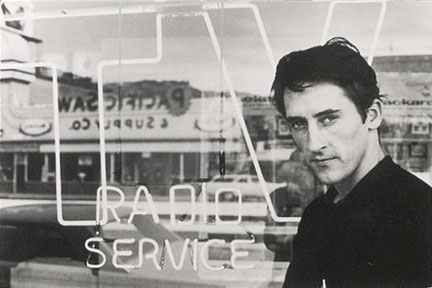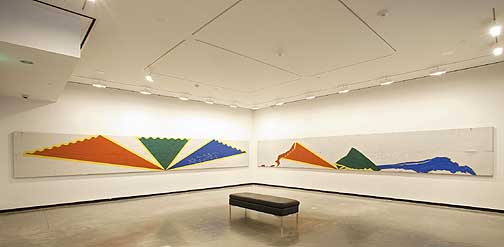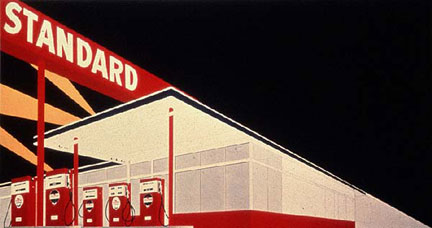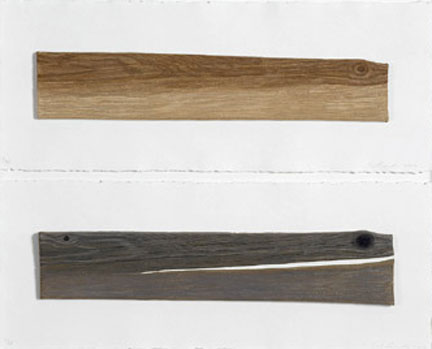
|
||
|
Portland art blog + news + exhibition reviews + galleries + contemporary northwest art
|
||
I will see where it takes me from here: A conversation with Ed Ruscha
That's right. Well, he was very rigorous and interesting. He was a task master. He taught a watercolor class and he went through elaborate steps to teach every student how to prepare the paper for the watercolors. You would have to prepare this paper by wetting and stretching it and the paper would be taut like the head of a drum. Irwin was a committed abstract painter and he was a vital person in my estimation during my early years. It just went on from there. He was one of several people that I studied under. Although I got quite a bit, not just from the teachers, but also from the students themselves, just being in that atmosphere. At one point you mentioned that in the sixties, you were the biggest collector of your own work. What was that like? There is more than a shred of truth there. It was about 1961 when I really got swinging into my own art. I had it for a few years before I exhibited it, and I didn't sell too much of my early work. Even during exhibits I would only sell one or two things. So I held on to quite a bit of my own work during the early years. Yeah, one of the first things that I did was called Sweetwater. It was a half-abstract and half-figurative painting. The top half of the painting was a washy kind of abstraction, and there was a very clear, clean hairline that was done with ink that ran through the whole thing. The bottom half had the words Sweetwater which was the name of a town that I had hitchhiked through in Tennessee. I was doing those towns that I had visited while I was hitchhiking. I had a little voyage that I was on then.
I was travelling to ruins outside of Mexico City, and I saw this very large wall that had a painting on it. There was no commercial message, which was intriguing to me because there is so much advertising down there. The image struck me because it was sort of like sun rays coming from a central point, and it just had a great appeal to me. I thought about it and eventually photographed it. I wanted to paint my version of that image. I liked the anonymity and urban-guerilla feeling to it. It just seemed to me like someone had painted this thing on the side of a wall and left it. That was enough to intrigue me. I just reproduced the image in my painting, and then I did another version of it that implied some kind of decline to the imagery. The banners begin to sag over upon themselves in Azteca in Decline. That was the whole story. Somehow the imagery reminded me of Montezuma or the Aztec civilization. Were you by any chance travelling to Teotihuacan? Yes, that is where it was. I have always wanted to see it but I have not had the opportunity to go there yet. It is a great trip. It is about an hour's drive outside of Mexico City. The mural was on the highway approaching Teotihuacan. It was maybe half way there, and I would like to know if it is still around. You have often commented that the diagonal line is an important element of your work. Do you use the diagonal because it automatically implies a sense of space or depth to the canvas, or because of its allusion to a vanishing point? I always come back to something figurative. I am always reminded of those scenes in the movies that I saw as a kid where there would be a train approaching that would suggest people travelling. The train would start at the lower, right hand corner and then in two or three seconds it would zoom in with the noise of a train and cover the entire area of the screen. That experience seemed to stick with me. The diagonal for me is like the zoom of a train, it has affected me and I have based several paintings on those sensations. I will see where it takes me from here.
I think that it is. It is one of the few pictures where that is actually happening. I am still trying to understand the whole story there, but it seems I impressed by things that are behind and in front of me. It is all right there.
You mean as to the deterioration of the image? Yes. I imagine it as being ... I know that I was taking great artistic license here, but how it would fall if it were made out of a certain material. I tried to imagine out the banner would fall if it was made out a material half way between paper and cloth. It is a kind of fantasy. It is part of the fantasy world to invent how something deteriorates. That is all based on my feelings about everything. In Azteca and Azteca in Decline, you were not just recreating the banners but you were also recreating the physical characteristics of the wall, like stains and spots. Is that correct? Yes, it implies a kind of aged appearance because of the character of the wall that it was on. I believe the wall panels were wood, although I am not sure. I never went up to the work. I would like to go back down there and find that thing to see what it looks like today (laughs). Can you tell me about the graffiti on the right side of the painting? I do believe that the graffiti on the actual mural was original and real. It was not part of the design of the mural originally. I think that someone came along and put the graffiti there. I even did a search with some knowledgeable people about graffiti in Mexico, and we really could not come up with any answers. In my second painting, I am painting the graffiti almost as though it did not exist. It is just floating there. It is even part of the thing that is falling apart. There are some inconsistencies in there. That is my license as an artist. (laughs)
Two of your recent prints are going to be included in the exhibition at the Portland Art Museum. They are New Wood/ Old Wood. Can you tell me about the process behind the prints? The prints are embossed works on paper. They are part of the same story about the old and the new that I am telling with the larger paintings. They are made in a workshop here in an edition of 75 and are paper reliefs. I found this piece of wood that I really liked, and I wanted to reproduce it in its original form and then have an aged version. I found the piece of wood in the desert. Weathered wood is something that figures into my life as an artist. I don't know why, but it is just one of those things that you feel comfortable with. I was attracted to it, and I had the desire to make something out of it. Over the years you have made paintings out of both oil paint and acrylic paint. How do you choose your materials for a painting? I do not use oil paint very much anymore. About twenty years ago, I began to move away from it and starting using acrylics. I consider the medium to be secondary. I could paint my pictures with oil paint if I wanted to, but I somehow found a friend with the acrylic paint. They seem to be easier for me to use. I never thought that I would make the switch. I was committed to oil paint, but now here I find myself using acrylics. (laughs) Did you make the switch because you can make cleaner lines with acrylic paint? In oil paint, you inevitably get the a little softening at the edges as the oil bleeds into the support. Not necessarily, some things are very good with oil paint. It is really hard to say. I am always learning about my materials. Each material has its own kind of latitude, and each type of paint has its own advantages and disadvantage. I am mostly using acrylics now. I responded to the mural because of its deep iconography from days past. Like the image of the eagle that you see everywhere in Mexico, including coins that you see throughout history. These iconic, nationalistic and cultural logos have more or less stuck with me. I felt like I was saying Mexico and ancient Mexico. This feeling came from being overwhelmed the culture of Mexico. The gas stations are a modern invention. I think that the Azteca represents something that is much older that also has the colors of Mexico. The image is full of signifiers and suggestions that bring up this ancient culture whereas the gas stations are twenty seconds ago. Do you go to Mexico often? No, I don't. I was there for an exhibit at the Tamayo Museum, and luckily I came across the wall painting. I feel fortunate for that experience. Max Ernst said the best thing ever, he said: "Cut off an ear." (laughs) That is his advice to young artists, and I can't do any better than that. Posted by Arcy Douglass on June 10, 2008 at 1:15 | Comments (2) Comments Fantastic interview. I just wrote about my affection for Ed Ruscha and his use of text and how it impacts me. Your interview is yet another great insight into a brilliant artist and it's nice to read about the progression from Standard Station to the current banner works. Thank you. Posted by: Chris Rusak This is a simply a stellar show and it isnt even fully installed yet. It opens on the 14th, yet even behind the stanchions and big shipping crates those two big paintings make that whole room vibrate. Installing them facing eachother in the corner of a square room is really powerful, ideal even. Posted by: Double J Post a comment Thanks for signing in, . Now you can comment. (sign out)
(If you haven't left a comment here before, you may need to be approved by
the site owner before your comment will appear. Until then, it won't appear
on the entry. Thanks for waiting.)
|
| s p o n s o r s |
 |
 |
 |
 |
 |
 |
 |
 |
 |
 |
 |
 |
 |
 |

|
Site Design: Jennifer Armbrust | • | Site Development: Philippe Blanc & Katherine Bovee | |








![[TypeKey Profile Page]](http://www.portlandart.net/nav-commenters.gif)